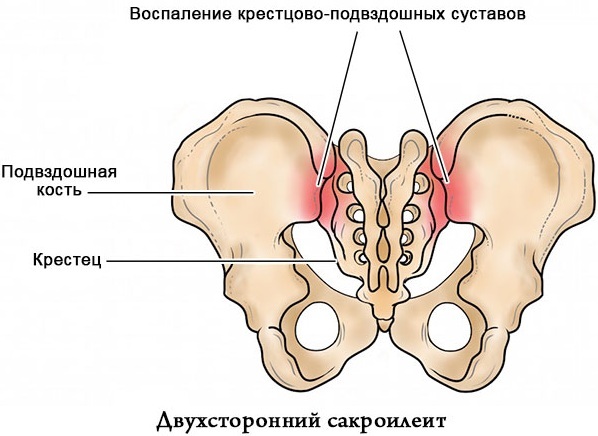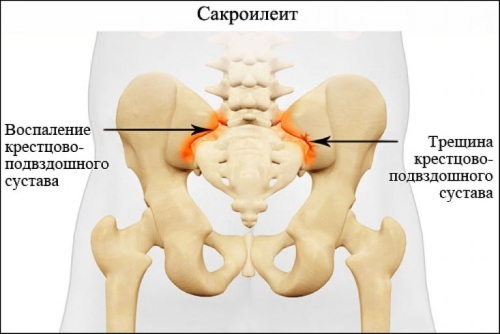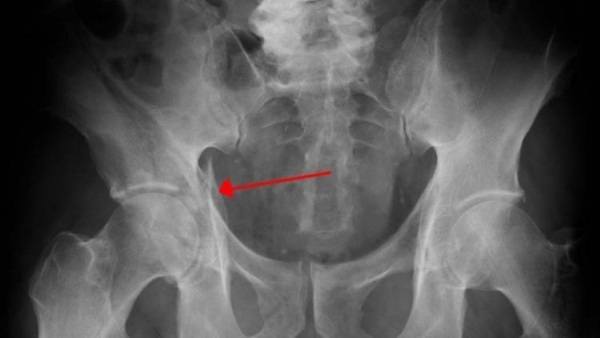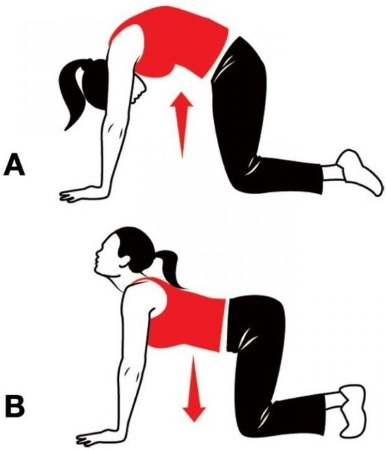Sacroiliitis is an inflammatory process in sacroiliac joint, that is, the part that joins the spine to the pelvis. It is mainly provoked by the defeat of the intervertebral joints, systemic diseases of the connective tissue, less often it is diagnosed as an independent pathology.
Sacroiliitis of the sacroiliac joint causes pain in the pelvic region, dysfunction of the spine, and when neglected leads to disability. The symptoms that appear will depend on the intensity of the inflammatory process and provoking factors. With timely diagnosis and treatment, the prognosis is favorable.
Record content:
- 1 Classification of sacroiliitis
- 2 Stages of the disease
- 3 Symptoms
- 4 Reasons for the appearance
- 5 Diagnostics
- 6 When to see a doctor
- 7 Prophylaxis
-
8 Treatment methods
- 8.1 Drug treatment
- 8.2 Traditional methods of treatment
- 8.3 Gymnastics
- 9 Possible complications
- 10 Video about sacroiliitis
Classification of sacroiliitis
Sacroiliitis of the sacroiliac joint is classified according to such parameters as the nature, area of distribution and localization of the affected area, as well as the etiology of the disease.
Depending on the etiology, the disease has 2 forms:
- Primary sacroiliitis - inflammation occurs in the sacroiliac joint and is limited to its structures. This can happen after injury, infection, or damage to bone tissue by tumor processes directly in the spine.
- Secondary sacroiliitis - has a more complex origin, since joint damage is a sign of another systemic disease. Most often these are rheumatological pathologies that provoke a change in the protective function of the body, in which the processes of destruction of its own connective tissue cells are triggered.
The inflammatory process can affect individual tissues of the joint, which is why sacroiliitis is distributed to:
- synovitis - damage to the inner layer of the articular bag;
- panarthritis - all components of the joint become inflamed;
- osteoarthritis - damage to the upper tissues of the joint
Depending on the root cause of inflammation, sacroiliitis is divided into:
- aseptic (infectious or allergic) - develop when the immune system malfunctions (Betherev's disease, rheumatoid, psoriatic, reactive arthritis);
- specific - are caused by infectious, bacterial and viral invasions;
-
non-specific (purulent) - accompanied by purulent damage to the bone and tissues.

The defeat can cover the entire joint, or a separate part of it. Depending on the localization of inflammation, one-sided (left or right) sacroiliitis is distinguished. If two joints are damaged, then the doctor makes a conclusion about the bilateral form of the disease.
Stages of the disease
If sacroiliitis of the sacroiliac joint is suspected, symptoms are not the only criterion by which a possible pathology can be determined. The patient is sent for an X-ray examination to determine the degree of joint damage and the stage of the disease.
The X-ray stage of sacroiliitis is established according to the Kellgren classification based on the image:
- 0 stage (normal) - the distance between the subchondral plates is not widened, the joint surfaces are without deviations.
- Stage 1 (suspicious changes) - fuzziness and unevenness of the edges of the joint is visible, sometimes in the center of the joint there is a slight thickening of bone trabeculae and compact bone matter (subchondral osteosclerosis).
- Stage 2 "Initial saroileitis" (obvious minimal changes) - moderate replacement of natural connective tissue in the area under the articular cartilage in both ilia; areas of pseudo-expansion of the joint space are visible, alternating with areas of narrowing, small local areas of erosion or sclerosis.
- Stage 3 "Active sacroiliitis" (strong destructive processes) - all manifestations of the initial sacroiliitis are sharply increased, clearly manifested increased bone leakage) as a whole is manifested by such general signs: density, the edges of the bone are blurred with erosions on all surfaces joint. The joint gaps in the picture are not fully visible due to pronounced osteosclerosis. Large cystic lesions in the subchondral bone may be observed.
-
Stage 4 "Inactive sacroiliitis" (advanced changes) - complete ankylosis of the articular structures (immobilization).

If the disease has passed into the third stage, then conservative methods of treatment often do not give a positive result, surgical intervention is indicated for such patients. At the fourth stage, the patient is disabled, with the inability to move freely
Symptoms
Sacroiliitis of the sacroiliac joint (symptoms depend on the etiology and severity):
- pain in the region of the sacrum on the side of the inflamed joint, which radiate to certain parts of the lower limb;
- breathing and heartbeat disorders;
- numbness of the lower extremities;
- subfebral temperature indicators;
- fast fatiguability.
The main manifestation of the disease is considered to be pain in the spine, which, with the development of inflammation, increases.
In addition, separate symptoms are characteristic for each type of sacroiliitis. The purulent form of the disease is characterized by a sharp pain in the lower spine and a rise in temperature.
With the aseptic form of pathology, the symptoms manifest themselves weakly, more often they cover the entire joint. With a specific infectious form, the pain rapidly increases in a certain position, the body temperature rises. Sometimes there are body aches, chills, lacrimation.
Reasons for the appearance
Factors affecting the appearance of primary sacroiliitis are:
- injuries, bruises;
- dislocations of the sutava;
- prolonged physical activity;
- pregnancy in the third trimester, when the pelvic bones expand.
More often, sacroiliitis develops as a consequence of another pathological process in the body and is only a symptom of a systemic disease (secondary sacroiliitis).
Causes and provoking factors of sacroiliitis, depending on the type:
| Disease type | What is the cause of the pathology |
| Non-specific (purulent) sacroiliitis | Osteoomyelitis, abscess breakthrough, joint infection in case of an open wound
|
| Specific sacroiliitis | Tuberculosis, syphilis, brucellosis - pathogens of which through the blood and lymphatic vessels settle in the joint |
| Aseptic sacroiliitis | Spondyloarthritis, rheumatoid and psoriatic arthritis, tumors (a malfunction in the immune system, in which the body perceives its cells as foreign) |
Sacroiliitis of the sacroiliac joint (symptoms of which appear in childhood) can be caused by congenital joint dislocations, incomplete contraction of the sacral vertebrae. In this case, a conclusion is made about sacroiliitis of "unclear etiology".
Diagnostics
When symptoms of the disease occur, you need to contact an orthopedic traumatologist. The doctor examines the patient, takes anamnesis and prescribes a number of laboratory and instrumental studies.
The main instrumental diagnostic method is X-ray examination, carried out in a direct projection, less often local imaging with the patient's turns is performed. At the initial stages of the disease, pathological changes are not pronounced, which complicates the diagnosis.
In such cases, the patient is referred for magnetic resonance therapy. MRI is available in many medical institutions, both public and private. The price of such a study is much higher compared to an X-ray (7,000 rubles. for one section of the spine), however, MRI gives clearer results.
For additional information, tests are prescribed that determine:
- erythrocyte sedimentation reaction;
- the level of leukocytes in the blood;
- antibodies in the blood to a specific microorganism.
Necessarily, the doctor pays attention to additional specific symptoms:
- Raimista. Pain with pressure on the sore joint from behind.
- Baer. The man lies on his back. The specialist presses on the pubic articulation perpendicularly downwards, pain is felt in the sacrum.
- Makarov. Pain appears when the doctor taps a diagnostic hammer in the articulation area.
- Genslen. With a strong flexion of the leg joint, pain is activated at the bottom of the spine from a similar side.
- Imagine. The patient, sitting, straightens his back and puts one leg on the other, pain appears in the hip joint.
When to see a doctor
Medical help should be sought immediately, even with mild back pain, indicating a possible sacroiliitis. If treatment is started on time, then serious consequences can be avoided.
If you suspect sacroiliitis, first of all, you need to contact an orthopedist or traumatologist. Since sacroiliitis often appears against the background of another disease, you may need to consult additional specialists.
If an infectious form of the disease is diagnosed, an additional appointment is made by an infectious disease doctor, with autoimmune sacryleitis - by an immunologist.
If the disease is detected at the last stage, the treatment is carried out by the surgeon by way of surgery.
It is important not to self-medicate so as not to aggravate the situation.
Prophylaxis
Due to the large number of factors provoking sacroiliitis, it is impossible to completely exclude the possibility of developing the disease by means of preventive methods. However, by observing some of the recommendations of doctors, you can significantly reduce the risk of pathology.
It is important to lead a healthy lifestyle, give up bad habits, strengthen the immune system, eliminate infectious foci in a timely manner, and treat diseases. It is necessary to limit ourselves from prolonged physical effects on the joint and prevent hypothermia.
Be sure to introduce exercises, gymnastics, yoga, swimming into your daily routine. It is also necessary to limit the stay of the spine in one position for a long time.
Treatment methods
In the treatment of sacroiliitis, attention is initially paid to the causes and severity of its course. If aseptic forms are treated conservatively, then chronic purulent pathology - by joint resection.
Drug treatment
Sacroiliitis of the sacroiliac joint, the symptoms of which need to be stopped and the root cause removed, initially begin to be treated with medications. This method is most effective at the initial stage of the disease. Prescribing drugs is individual and requires strict adherence to the doctor's prescriptions.
It is possible to reduce inflammation, relieve pain and prevent possible consequences with the help of non-steroidal anti-inflammatory drugs. The greatest effectiveness for the joint is presented in such preparations as "Diclofenac", "Meloxicam", "Analgin", "Ibuprofen", "Nimesulide".
In pharmacology, they are presented in the form of injections for injections, tablets, ointments. If the doctor has prescribed pills, then you need to take them after meals after 1-2 hours, drinking plenty of water. To improve geodynamics in all components of the joint, "Trental" and or "Pentoxifylline" are prescribed
Anti-inflammatory drugs are taken for all types of sacroiliitis. Further, depending on the severity and form of the disease, the appointment differs.
If the disease has developed against the background of infection of the joint (the temperature rises sharply, severe pain, chills appear), then the doctor ascribes antibiotics with the definition of sensitivity to the pathogen. More often used intramuscularly - "Penicillin", "Streptomycin", "Ceftriaxone". To relieve general intoxication, enterosorbents are taken in parallel, for example, Enterosgel.
For the effectiveness of drug treatment, physiotherapy is indicated (electrophoresis, laser radiation of the sacrum region, pulsed magnetotherapy).
Traditional methods of treatment
Traditional methods as an independent therapy will not bring a positive result. They are only used as an adjunct to the treatment prescribed by your doctor.
For the effectiveness of treatment, experts recommend taking a 20 ml solution of mummy. 2 times a day. It is also helpful to take eggshell powder to strengthen the joint. The shell of 1 egg contains 700-800 mg of calcium, in composition almost identical to human bones. The daily dose is 0.5 teaspoon of powder, which must be divided into 2 doses.
Other folk remedies for sacrielitis:
- Fresh chicory (steamed and applied to the affected area);
- Cabbage (wrap a sore joint with leaves and leave overnight);
- Celandine (use plant juice to rub the joint);
It is recommended to wear a special semi-rigid lumbosacral corset during treatment and minimize physical activity. This helps to limit range of motion and helps reduce discomfort.
Gymnastics
Sacroiliitis of the sacroiliac joint (symptoms of an acute process, which are arrested) is recommended to be comprehensively treated with gymnastics, which is useful for the restoration of joint mobility. The exercises are based on stretching and breathing exercises. You need to do it every day for 30 minutes, linger in each position for up to 1 minute.
Stretching gymnastics:
- Lie on a hard surface with your back, legs bent at the knees. Then, with your hands, pull the toe of one leg towards you, trying to straighten it. Repeat the manipulation with the other limb.
- Bend down into the "Cat" pose, and then bend in the opposite direction.
- Lie face up, lay your right leg on your left, turn the body in the same direction. Repeat in mirror image.
- Put your legs together, lunge your legs forward, keeping it straight, with your hands strive to the surface.
When doing gymnastics, the main thing is to relax in each position and feel the muscle tension.
Breathing exercises can be done while walking. Experts recommend learning to inhale in 2-4 steps, and exhale in 4-8 steps. You only need to start exercising with the permission of your doctor. If painful discomfort arises in the process, it is prohibited to continue gymnastics.
Possible complications
The duration and result of treatment depends on the type and stage of the disease. If the pathology has arisen against the background of rheumatism, then therapy continues for several years (exacerbation stages alternate with remissions).
Usually, the causes of the disease of an infectious nature lend themselves well to elimination and treatment, compared to autoimmune disruptions.
If treatment is not carried out, then the result is severe destruction of the joint, as well as damage to the pelvic bones. Launched sacroiliitis leads to a gradual loss of pelvic mobility, as well as difficulty moving the legs. In this case, only a complex operation can help.
In the absence of adequate treatment for sacroiliitis of a purulent nature, pus can spread to neighboring organs and tissues. If the infection enters the spinal canal, the spinal cord may become infected.
Prolonged presence of pathogens in the area of the pubic and sacroiliac joint provokes infection of the genitourinary organs. In men, on this basis, prostatitis with loss of erectile function may occur. In women, inflammation is dangerous by the development of diseases of the uterus and its appendages.
Symptoms of sacroiliac joint sacroiliitis are not always pronounced; with delayed therapy, a person may remain disabled for life. Therefore, it is highly discouraged to delay the visit to the doctor.
Article design: Vladimir the Great
Video about sacroiliitis
Diagnostics and treatment of sacroiliitis:



